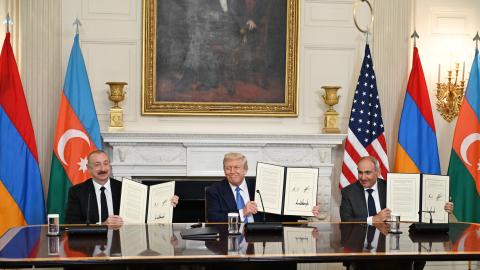Tensions between the US and Russia dramatically increased last week after two Russian fighter jets forced a US surveillance drone flying in international airspace to crash land into the Black Sea.
Footage from the MQ-9 drone released by the Pentagon, showed a Russian Su-27 fighter attempting to dump jet fuel on to the drone in midair at least twice. US authorities say that during the last attempt one of the Russian jets struck the drone, damaging its propeller and forcing the aircraft into the Black Sea.
In recent years Russia has harassed several US ships and planes operating in the Black Sea. In February 2021, a Russian Su-24 fighter-bomber harassed a US Navy ship operating in international waters in the Black Sea. In August 2020, two Russian jets were accused of flying in an “unsafe and unprofessional manner” after passing within 30 meters of an American B-52 flying in international air space above the Black Sea. A Pentagon official also claimed that 90 percent of America’s drone flights in international airspace above the Black Sea were intercepted by Russian jets. But this recent incident with the MQ-9 was the first time that physical contact had been made between a Russian plane and an American drone.
There is no doubt that Russia purposely harassed the MQ-9. Even though Moscow denies this, there is video evidence showing otherwise. However, what is unknown is whether Russia deliberately or accidently struck the drone. Maneuvering a fighter jet in such a way to make physical contact with the drone in midflight is a risky business. Not only would the Russian pilot be putting his life at risk by doing so, he would also risk damaging his plane. According to open-source intelligence reporting, Russia has already lost at least 79 aircraft since it invaded Ukraine last year. Certainly, Russia cannot afford to lose another multimillion-dollar fighter jet as a consequence of such reckless behavior. Regardless of whether it was an accident or a deliberate act, the incident shows a lack of professionalism in the Russian Air Force.
This incident should be a wakeup call for the US in the Black Sea region, an important crossroads between Europe, Asia, and the Middle East. Oil and gas pipelines, as well as fiber-optic cables, run along the seabed, while on the surface hundreds of ships crisscross it daily, moving people and goods. For centuries the Black Sea has been fought over by some of the world’s major empires. Throughout history, it has proved to be one of the most geopolitically and economically important locations in the broader Eurasian region.
Even for a country thousands of kilometers away, as the US is, the Black Sea is important. The US has three NATO allies (Bulgaria, Romania and Turkey) along the Black Sea that it is required to defend and protect by a treaty agreement. There are also two important NATO partners (Ukraine and Georgia) that are Black Sea states. Furthermore, Russia has used its presence in occupied Crimea as a springboard for its military operations in places such as Syria.
It remains to be seen how the Biden administration will respond to this latest incident, but something must be done. The MQ-9 is not your standard off-the-shelf commercially available drone. It is a sophisticated unmanned aerial vehicle that, depending on the exact variant that was forced to crash, costs between $15 million and $30 million to build. The MQ-9 was operating in international airspace with its air transponder turned on. It had every right to fly where it was at the time of the incident. Accident or not, it was Russia’s cavalier behavior that caused this incident.
Now there is a scramble to recover any remaining debris from the crash site. The Pentagon said it was able to remotely delete sensitive data on the drone before it crashed. No US ship has been in the Black Sea since fighting broke out in Ukraine last year. It remains to be seen how quickly the US could get a salvage ship into the Black Sea to recover some of the debris. There is no doubt that Russia is trying to recover the debris too. If successful, it could help Russia, and by extension Iran, learn about the technology used in the MQ-9.
However, the most immediate thing for the US to do is fly another drone as soon as possible in the same location. The US must show that it will not be deterred by the downing of its MQ-9. Otherwise, it will become open season against other ships and aircraft operating in international waters and air space around the world. Last week it was a US drone flying in international airspace in the Black Sea that was forced down. Tomorrow it could easily be a drone from a Gulf state flying in international airspace over the Gulf of Oman.
The downing of the MQ-9 is a serious matter not just for the US but also for the international community. The global commons must remain open to everyone.

















